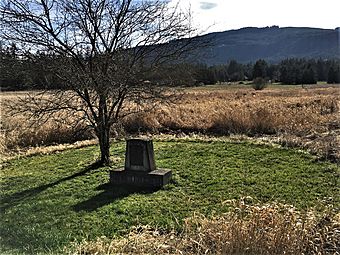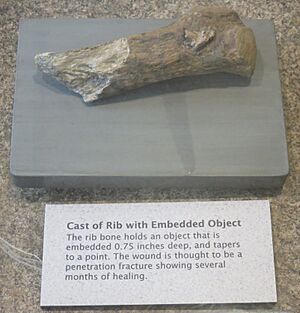Manis Mastodon Site facts for kids
Quick facts for kids |
|
|
Manis Mastodon Site
|
|
 |
|
| Lua error in Module:Location_map at line 420: attempt to index field 'wikibase' (a nil value). | |
| Nearest city | Sequim, Washington |
|---|---|
| NRHP reference No. | 78002736 |
| Added to NRHP | March 21, 1978 |
The Manis Mastodon site is an exciting archaeological site located on the Olympic Peninsula near Sequim, Washington. It covers about 2 acres (0.8 hectares). This site became famous because scientists found the bones of an American mastodon here. What made it special was a 13,800-year-old spear point, made from another mastodon's bone, stuck in its rib! This amazing discovery shows us how early humans might have lived in North America. The site was added to the National Register of Historic Places in 1978.
Contents
Discovering the Mastodon Site
On August 8, 1977, a farmer named Emanuel Manis was digging on his land. He was using a large machine called a backhoe. Suddenly, he found something huge: the tusks of an American mastodon! This was a very exciting moment.
Soon after, a team of archaeologists arrived. Dr. Carl Gustafson from Washington State University led the dig. They carefully uncovered more of the mastodon's bones.
The Ancient Spear Point
During their work, the team found a rib bone from the mastodon. Inside it was what looked like a spear tip. This tip was made from the bone of a different mastodon. What was even more amazing was that new bone had grown around the spear point. This meant the mastodon had been hurt by the spear but had lived for some time afterward.
Dr. Gustafson believed this was the oldest proof that humans and mastodons had met in the Americas. However, some people weren't sure if the point was definitely made by humans.
Proof from New Studies
The debate ended in 2011. New scientific studies of the mastodon remains confirmed Dr. Gustafson's ideas. They proved that the spear point was indeed very old and made by humans.
Scientists also looked at how the mastodon's 6,800 kg (15,000 lb) fossil was lying. It was on its left side, and its skull was turned completely around. Dr. Gustafson realized this couldn't have happened naturally. He figured that early humans must have moved the mastodon's body.
Archaeologists were also surprised to find a mastodon here at all. Mastodons usually ate trees. But pollen samples from the site showed no signs of trees from that time. Instead, there was mostly sedge and cattail pollen.
Other Discoveries at the Site
Above the mastodon layer, archaeologists found other interesting things. They found ash from the eruption of Mount Mazama, which happened about 6,700 years ago. In this layer, they also found a different type of spear point. This point was in the style of Coastal Olcott points, which are known to be from about 9,000 years ago.
The Manis site also contained bones from other animals, like caribou and bison. Some of the bison bones showed clear signs that humans had cut them. This suggests that early people hunted and butchered these animals.
Besides sedge and cattail, other plant remains were found. These included Canadian buffaloberry, blackberry, wild rose, willow, and alder. These plants tell us about the environment long ago.
More Mastodons and Tools
Dr. Gustafson continued digging at the site for eight years. During this time, he found parts of two more mastodons. He also found stone tools and other objects made from bone. However, he didn't find any evidence of a human camp. This means the people might have only visited the site to hunt or butcher animals.
Before the Manis site was discovered, most very old archaeological sites west of the Cascade Range were thought to be between 6,000 and 9,000 years old. The Manis site, dated to over 12,000 years ago, changed that idea.
The Site Today
For many years, Emanuel and Clare Manis welcomed over 50,000 visitors to their property to see the dig site. In 1978, when the site was added to the National Register of Historic Places, Senator Henry M. Jackson made the announcement.
In 2002, on the 25th anniversary of the discovery, Emanuel Manis's wife donated the site to the National Archaeological Conservancy. This group helps protect important archaeological places. The actual mastodon bones were given to the Sequim Museum & Arts in Sequim. You can see them on display there today. A copy of the bone spear point is also on display.
New Scientific Findings
In October 2011, scientists from Texas A&M University published new findings. They used DNA tests, CT scans, and radiocarbon dating on the mastodon and the spear point. The CT scan clearly showed that the spear point had been sharpened to a needle point by human hands. The radiocarbon dating showed the mastodon was about 13,860 to 13,763 years old.
For a long time, many archaeologists believed that the Clovis people were the first humans in North America. They thought the Clovis people lived here about 13,000 years ago. However, discoveries like the Manis Mastodon site are changing these beliefs. The Manis Mastodon site is about 800 years older than the Clovis culture. Other sites, like Monte Verde in Chile and Meadowcroft Rockshelter in Pennsylvania, also show that people were in the Americas much earlier.
The Manis Mastodon Site is still the oldest archaeological site on the Olympic Peninsula in Washington State. It is also one of the oldest in all of North America.
In November 2011, Shirley Manis, Emanuel Manis's daughter, wrote a children's picture book about the Manis Mastodon Site. It includes the most recent scientific information.
See also
 In Spanish: Manis Mastodon para niños
In Spanish: Manis Mastodon para niños


